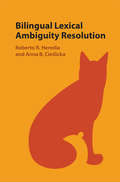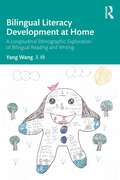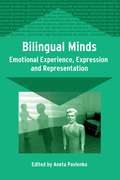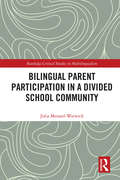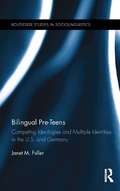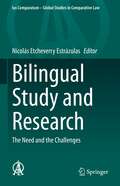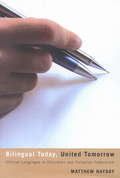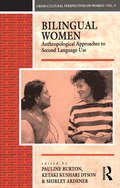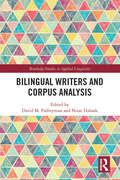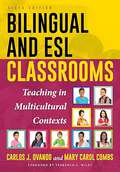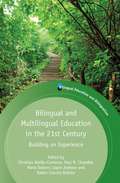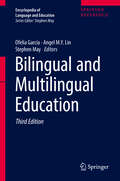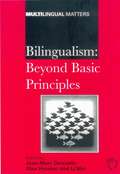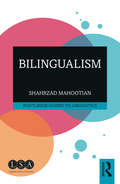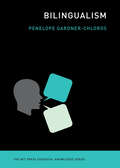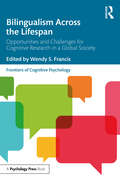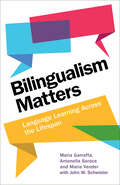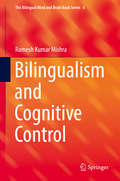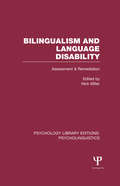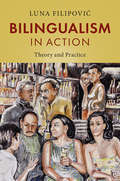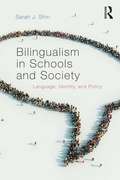- Table View
- List View
Bilingual Lexical Ambiguity Resolution
by Roberto R. Heredia Anna B. CieślickaThis book provides students and researchers of bilingualism with the most recent methodological and theoretical advances on how bilinguals resolve ambiguous information across languages. With reports on the latest findings from the behavioral and neuropsychological fields, the authors survey the latest research into bilingual language-system modelling and bilingual lexical ambiguity processing. Each chapter looks at bilingual ambiguity resolution both at the word and sentence levels, explaining how bilinguals ultimately comprehend ambiguous information arising from languages they already know. This volume not only explores enduring theoretical questions in bilingual research, such as bilingual representation and language processing, but also evaluates the extent to which the existing bilingual models can satisfactorily account for the most recent research findings.
Bilingual Literacy Development at Home: A Longitudinal Ethnographic Exploration of Bilingual Reading and Writing
by Yang WangThis book explores pedagogical implications for how children read, write, respond to literature, and begin to learn an additional language in the home context.Using a longitudinal ethnographic study, it explores a bilingual child’s literacy development over a span of four years from kindergarten to the third grade in a real-life home context in the United States. Written from a parent-researcher’s perspective, it illustrates the child’s Mandarin Chinese and English language support at home and in the community during the pandemic, and charts the development in bilingual reading and writing, multimodal reading responses to children’s literature, and learning Spanish as a third language. Through rich and detailed descriptions, the case study methodology allows a clear articulation of the project’s focus and foregrounds the exploration of reading as a sociopsycholinguistic process, as well as highlighting multimodality in reading and writing responses, translanguaging, and bilingual and bicultural identities to study and teach culturally and linguistically diverse children.It will be a valuable resource for literacy researchers, scholars, and bilingual educators with interests in sociolinguistics, literacy education, bilingualism, and translanguaging.
Bilingual Minds
by Aneta PavlenkoDo bi- and multilinguals perceive themselves differently in their respective languages? Do they experience different emotions? How do they express emotions and do they have a favourite language for emotional expression? How are emotion words and concepts represented in the bi- and multilingual lexicons? This ground-breaking book opens up a new field of study, bilingualism and emotions, and provides intriguing answers to these and many related questions.
Bilingual Parent Participation in a Divided School Community (Routledge Critical Studies in Multilingualism)
by Julia Menard-WarwickThis volume theorizes parent participation in a bilingual school community in California, unpacking broader issues around language ideologies, language and power, and parent collaboration in diverse educational contexts. Highlighting data from a two-year ethnographic study of the school community, the book grounds this discussion in theories of discourse and bilingualism, with a focus on translanguaging and translingual practice. The volume points to a range of challenges and questions posed by the parents’ efforts to unite as a single school community, including linguistic inequality, cultural divides, and differing implicit beliefs on language. The book documents these efforts as a means to demonstrate the ways in which monolingual practices are reinforced in these settings, despite best efforts, but also as a point of departure to discuss implications and a way forward for parent collaboration in bilingual school communities more generally. Offering a nuanced portrait of the impact of parent collaboration in bilingual school communities, this volume will be of particular interest to graduate students and scholars in language education, applied linguistics, bilingualism, and sociolinguistics.
Bilingual Pre-Teens: Competing Ideologies and Multiple Identities in the U.S. and Germany (Routledge Studies in Sociolinguistics #6)
by Janet M. FullerThis volume examines the connection between socio-economic class and bilingual practices, a previously under-researched area, through looking at differences in bilingual settings that are classified as "immigrant" or "elite" and are thus linked to socio-economic class categories. Fuller chooses for this examination bilingual pre-teen children in Germany and the U.S. in order to demonstrate how local identities are embedded in a wider social world and how ideologies and identities both produce and reproduce each other. In so doing, she argues that while pre-teen children are clearly influenced by macro-level ideologies, they also have agency in how they choose to construct their identities with relation to hegemonic societal discourses, and have many other motivations and identities aside from social class membership which shape their linguistic practices.
Bilingual Study and Research: The Need and the Challenges (Ius Comparatum - Global Studies in Comparative Law #58)
by Nicolás Etcheverry EstrázulasThis book addresses the importance of bilingualism in legal education. Written by respected experts in the field, it presents reports on bilingual legal education in countries with such diverse cultures and histories as Belgium, Canada, China, the Czech Republic, Finland, France, Germany, Italy, Japan, Mexico, Romania, Singapore, Taiwan and the USA. The findings are also summarized in a General Report that was presented at the 20th IACL General Congress in Fukuoka, Japan.
Bilingual Today, United Tomorrow
by Matthew HaydayHayday shows how the language programs and policies initiated by the Trudeau government supported French-Canadian and Acadian minority communities, enabling them to develop minority language education systems and laying the groundwork for the minority language education rights contained in section 23 of the Canadian Charter of Rights and Freedoms. He examines how the dynamics of Canadian federalism shaped the implementation and development of language policy in six Canadian provinces and shows how advocates of these programs - politicians, bureaucrats, parents, lobbyists, and teachers - worked to ensure their success. These dynamic programs not only guaranteed minority language education rights but dramatically increased access to French second language instruction, particularly through the innovative new sector of French immersion.
Bilingual Today, United Tomorrow: Official Languages in Education and Canadian Federalism
by Matthew HaydayHayday shows how the language programs and policies initiated by the Trudeau government supported French-Canadian and Acadian minority communities, enabling them to develop minority language education systems and laying the groundwork for the minority language education rights contained in section 23 of the Canadian Charter of Rights and Freedoms. He examines how the dynamics of Canadian federalism shaped the implementation and development of language policy in six Canadian provinces and shows how advocates of these programs - politicians, bureaucrats, parents, lobbyists, and teachers - worked to ensure their success. These dynamic programs not only guaranteed minority language education rights but dramatically increased access to French second language instruction, particularly through the innovative new sector of French immersion.
Bilingual Women: Anthropological Approaches to Second Language Use (Cross-cultural Perspectives On Women Ser. #Vol. 9)
by Pauline Burton; Ketaki Kushari Dyson; Shirley ArdenerThis book studies women's language use in bilingual or multi-lingual cultural situations. The authors - social anthropologists, language teachers, and interpreters cover a wide variety of geographical and linguistic situations, from the death of Gaelic in the Outer Hebrides, to the use of Spanish by Quechua and Aymara women in the Andes. Certain common themes emerge: dominant and sub-dominant languages, women's use of them; ambivalent attitudes towards women as translators, interpreters and writers in English as a second language; and the critical role of women in the survival (or death) of minority languages such as Gaelic and Breton.
Bilingual Writers and Corpus Analysis (Routledge Studies in Applied Linguistics)
by David M. Palfreyman Nizar HabashThis innovative volume is one of the first to represent the usage of bilingual writers in both their languages, offering insight into language corpora as extremely valuable tools in contemporary applied linguistics research, and in turn, into how much of the world’s population operate daily. This book discusses one of the first examples of a bilingual writer corpus, the Zayed Arabic-English Bilingual Undergraduate Corpus (ZAEBUC), which includes writing by hundreds of students in two languages, with additional information about the writers and the texts. The result is a rich resource for research in multilingual use and learning of language. The book takes the reader through the design and use of such a corpus and illustrates the potential of this type of corpus with detailed studies that show how assessment, vocabulary, and discourse work across two very different languages. This volume will be of interest to scholars, policymakers, and educators in bilingualism, plurilingualism, language education, corpus design, and natural language processing.
Bilingual and ESL Classrooms: Teaching in Multicultural Contexts
by Carlos J. Ovando Mary Carol CombsNow in its 6th Edition, this classic text integrates theory and practice to provide comprehensive coverage of bilingual and ESL education. The text covers the foundations of bilingual and ESL education and provides a strong focus on what the teacher needs to know in a bilingual classroom. Woven throughout the text are quotes from bilingual and ESL students and teachers that illuminate the bilingual/ESL learning and teaching experience. Bilingual and ESL Classrooms is written for both preservice and experienced educators serving grades pre-K through 12—mainstream, bilingual, ESL, and special education teachers, as well as administrators, school counselors, and educational policymakers. New in the Sixth Edition This sixth edition presents updated research on and expanded coverage of key issues related to the education of English language learners in the United States such as continuing controversies and findings in demographics, the impact of globalization on K–12 public schooling, evidence-driven teaching practices, white normativity, using technologies developed for language minority populations, making sense of Census 2010, and achievement levels of ELLs in math and science. More specifically, this sixth edition includes: Coverage of the 2015 Every Student Succeeds Act. An expanded and updated “Human Face of Bilingual Students and ELLs.” A revised, co-authored student chapter. A thoroughly revised assessment chapter. A revised chapter on bilingual special education.
Bilingual and Multilingual Education in the 21st Century
by Christian Abello-Contesse Paul M ChandlerBilingual education is one of the fastest growing disciplines within applied linguistics. This book includes the work of 20 specialists working in various educational contexts across Europe, Latin America and North America to create a volume which is both comprehensive in scope and multidimensional in its coverage of current bilingual initiatives. The central themes of this volume, which draws on past experiences of bilingual education, include issues in language use in classrooms at elementary, secondary and tertiary levels; participant perspectives on bilingual education experiences; and the language needs of bi- and multilingual students in monolingual schools. This collection will be of interest to teachers and administrators in bi- and multilingual education programs, as well as scholars working in the field of language education.
Bilingual and Multilingual Education: Implications For Sla, Tesol, And Bilingual Education (Encyclopedia of Language and Education #Vol. 5)
by Ofelia García Stephen May Angel M. Y. LinIn this third, fully revised edition, the 10 volume Encyclopedia of Language and Education offers the newest developments, including an entirely new volume of research and scholarly content, essential to the field of language teaching and learning in the age of globalization. In the selection of topics and contributors, the Encyclopedia reflects the depth of disciplinary knowledge, breadth of interdisciplinary perspective, and diversity of socio-geographic experience in the language and education field. Throughout, there is an inclusion of contributions from non-English speaking and non-western parts of the world, providing truly global coverage. Furthermore, the authors have sought to integrate these voices fully into the whole, rather than as special cases or international perspectives in separate sections. The Encyclopedia is a necessary reference set for every university and college library in the world that serves a faculty or school of education, as well as being highly relevant to the fields of applied and socio-linguistics. The publication of this work charts the further deepening and broadening of the field of language and education since the publication of the first edition of the Encyclopedia in 1997 and the second edition in 2008.
Bilingual: Life and Reality
by Francois GrosjeanWhether in family life, social interactions, or business negotiations, half the people in the world speak more than one language every day. Yet many myths persist about bilingualism and bilinguals. In a lively and entertaining book, an international authority on bilingualism explores the many facets of life with two or more languages.
Bilingualism
by Alex Housen Jean-Marc DewaeleThe nine original papers in this volume have been written by international experts and deal with individual bilingualism, societal and educational phenomena, addressing issues such as bilingual usage, acquisition, teaching, and language planning and policy. The volume's major asset lies in its diversity of topics and in the range of languages and geographical regions covered. The perspective adopted is multidisciplinary, including linguistics, sociolinguistics, psychology, and applied linguistics.
Bilingualism (Routledge Guides to Linguistics)
by Shahrzad MahootianBilingualism provides a concise and lively introduction to bilingualism as a social and linguistic phenomenon and explains its impact on individuals and on society. Addressing questions such as what it means to be bilingual, how one becomes bilingual, and how exposure to more than one language can hinder or enhance a child’s cognitive development, this book features: an introduction to the linguistic, sociolinguistic, and cognitive outcomes of bilingualism, including bilingual language acquisition, the grammar of language-mixing, the link between language choice and identity, and the value of maintaining and promoting bilingualism; up-to-date overviews of the prominent concerns and facts about bilingualism; activities and discussion questions which invite readers to consider their own perspectives on bilingualism and how it manifests in their own lives and communities; links to relevant videos and suggested further reading, including topical novels, short stories, and essays. Aimed at students with no background in linguistics, this book is essential reading for anyone studying bilingualism for the first time.
Bilingualism (The MIT Press Essential Knowledge series)
by Penelope Gardner-ChlorosAll about bilingualism, in science and in life: the benefits and controversies, the individual experience, and the social significance.Nearly half the world's people are bilingual, but many have no clear understanding of what—aside from being fluent in more than one language—bilingualism means. This lively introduction by linguist Penelope Gardner-Chloros covers everything a bilingual (or curious monolingual) individual might want to know. The book discusses how bilingualism affects brain development and performance in the young and old, its social and political significance throughout time and around the globe, and how people experience and describe it. Gardner-Chloros looks at how both children and adults, become bilingual, how this affects learning, and what it means to be a bilingual family or family member. Drawing on the latest research, she offers a comprehensive but accessible account of the cognitive effects of bilingualism, and how the bilingual brain differs from the monolingual one. With the help of real examples, she outlines the impact of bilingualism on everyday speech and writing, from formal literature to social media, and lets speakers of various languages and backgrounds describe, in their own words, their experience of bilingualism and its impact on their lives. Informative, engaging, and wide-ranging, Bilingualism is the indispensable resource on a common but little understood phenomenon of far-reaching personal, social, political, and historical significance.
Bilingualism Across the Lifespan: Opportunities and Challenges for Cognitive Research in a Global Society (Frontiers of Cognitive Psychology)
by Wendy S. FrancisBilingualism Across the Lifespan explores the opportunities and challenges that are inherent in conducting cognitive research in an increasingly global and multilingual society. Divided into three sections, the book highlights the multifaceted and complex nature of bilingualism. The first section focuses on what every cognitive psychologist ought to know about bilingualism: the impact of bilingualism on cognition across the lifespan, the idea that bilinguals are not a special case, and the importance of bilingualism in cognitive research beyond language. The second section focuses on challenges inherent in bilingual research: diversity of bilingual experience, the assessment of proficiency, and finding matched comparison groups and materials. Finally, the book considers opportunities that are created when bilingualism is incorporated into the cognitive research enterprise. It illustrates how researchers of bilingualism leverage theory, methodology, and findings from single-language research, incorporate uniquely bilingual processes or representations, and target populations of bilinguals that help to establish universal properties. Bringing together leading international contributors, the book provides the reader with a better understanding of the nature of bilingualism and bilingual research as it relates to human cognition. It will be an essential read for all researchers and upper-level students of bilingualism and cognitive psychology more generally.
Bilingualism Matters: Language Learning Across the Lifespan
by Antonella Sorace Maria Garraffa Maria VenderWhat happens in the brain when learning a second language? Can speaking more than one language provide cognitive benefits over a lifetime? What implications does an increase in bilingualism have for society? And what are the factors that can promote and support bilingualism in children and adults? This book – a translated and adapted version of Il Cervello Bilingue (2020) - answers these questions and more, providing the reader with a comprehensive yet concise guide on different topics related to bilingualism. Based on the results of the most recent studies conducted internationally, it discusses recent research findings, explains terminology, and elaborates on the current state of the field, with the aim of providing families and society with suggestions about how to encourage bilingualism. Written in an engaging and accessible style, it takes both academics and readers with no prior knowledge of the field on a journey into the bilingual brain.
Bilingualism and Bilingual Education: Politics, Policies and Practices in a Globalized Society
by B. Gloria Guzmán JohannessenThis volume presents a multinational perspective on the juxtaposition of language and politics. Bringing together an international group of authors, it offers theoretical and historical constructs on bilingualism and bilingual education. It highlights the sociocultural complexities of bilingualism in societies where indigenous and other languages coexist with colonial dominant and other prestigious immigrant languages. It underlines the linguistic diaspora and expansion of English as the world’s lingua franca and their impact on indigenous and other minority languages. Finally, it features models of language teaching and teacher education. This book challenges the existent global conditions of non-dominant languages and furthers the discourse on language politics and policies. It does so by pointing out the need to change the bilingual/multilingual educational paradigm across nations and all levels of educational systems.
Bilingualism and Cognitive Control (The Bilingual Mind and Brain Book Series #6)
by Ramesh Kumar MishraThis thought-provoking monograph makes a multidisciplinary case for bilingualism as a possible enhancer of executive function, particularly cognitive control. Its central focus is the cognitive operations of the bilingual brain in processing two languages and whether they afford the brain a greater edge on neuroplasticity—in short, a cognitive advantage. Major issues and controversies in the debate are analyzed from cognitive neuroscience, psycholinguistic, and integrative perspectives, with attention paid to commonly and rarely studied domains at work in bilingual processing. The author also pinpoints future areas for improved research such as recognizing the diversity of bilingualism, not simply in languages spoken but also in social context, as seen among immigrants and refugees. Included in the coverage: The evolution of bilingualism.What goes on in a bilingual mind? The core cognitive mechanisms.Cognitive advantage of bilingualism and its criticisms.Neuroscience of bilingualism.Bilingualism, context, and control.Attention, vision, and control in bilinguals. With its cogent takes on ongoing questions and emerging issues, Bilingualism and Cognitive Control is of immediate interest to bilingual researchers and practitioners interested in understanding the behavioral aspects and neurobiology of bilingualism and the dynamic character of the bilingual/multilingual/second language learner’s mind, as well as the growing number of advanced undergraduate and graduate students interested in the psychology/psycholinguistics of bilingualism, bilingual cognitive psychology, cognitive science, and cognitive neuroscience.
Bilingualism and Language Disability: Assessment and Remediation (Psychology Library Editions: Psycholinguistics)
by Nick MillerSociety is becoming increasingly multi-lingual and this presents monolingual professionals, particularly those in special education and speech pathology, with severe problems. Is the language delay in a child from a bilingual environment a result of this background or is there a specific speech problem? Is a child’s poor performance in school due to his problems of coping with two languages, or does he need remedial teaching? Originally published in 1984, this book is not concerned with second language learning, but with speech and learning difficulties in bilingual children as they are presented to remedial teachers, psychologists and speech therapists. To this end the first group of specially written articles deals with the patterns of language usage in bilingual communities and the social and psychological factors which shape these patterns; with processes in normal bilingual language acquisition; and with the relationship between cognitive development and growing up with two languages. Management issues and methods involved in helping children with language problems are also tackled: they include taking case histories, family liaison, counselling, bilingual programmes, mother tongue teaching, curriculum development and the training of personnel to work in the bilingual-bicultural field. This book provided a great deal of practical help, in a field that was relatively new at the time of writing, and helped to enlighten readers on the issues involved and assist in crystalising thought and directing future research.
Bilingualism in Action: Theory and Practice
by Luna FilipovićBilingual language behaviour is driven by numerous factors that are usually studied in isolation, even though individual factors never operate alone. Bringing together key insights from psycholinguistics and sociolinguistics, Luna Filipović presents a new model of bilingual language processing that captures bilingualism within and across minds. The model enables readers to explain traditional puzzles in the field, and accounts for some apparently contradictory reports in different studies. It shows how theory can be applied in practice and how practice feeds back into theory, with mutual benefits. Bilinguals are studied in action, when they interact with other bilinguals or monolinguals, when they recall witnessed events in real life and in the lab and when they translate and interpret for the benefit of monolinguals. This interdisciplinary take on bilingualism in action will lead to new research on bilingualism itself, and to applications in forensic linguistics and translation studies.
Bilingualism in Education: Aspects of theory, research and practice (Applied Linguistics and Language Study)
by Jim Cummins Merrill SwainThis is a remarkably interesting and useful book...it makes a significant contribution to our knowledge and understanding of both bilingualism and education.'Journal of Education Policy
Bilingualism in Schools and Society: Language, Identity, and Policy
by Sarah J. ShinThis book is an introduction to the social and educational aspects of bilingualism. It presents an overview of a broad range of sociolinguistic and political issues surrounding the use of two languages, including code-switching in popular music, advertising, and online social spaces. It offers a well-informed discussion of what it means to study and live with multiple languages in a globalized world and practical advice on raising bilingual children.
